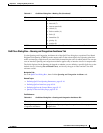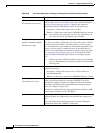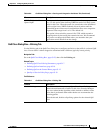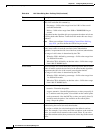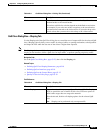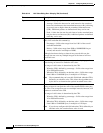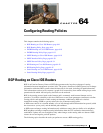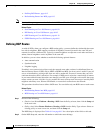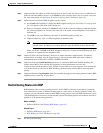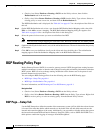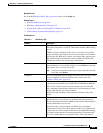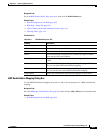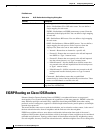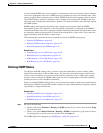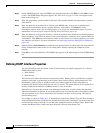
64-3
User Guide for Cisco Security Manager 4.4
OL-28826-01
Chapter 64 Configuring Routing Policies
BGP Routing on Cisco IOS Routers
Step 3 (Optional) Enter the addresses of the networks that are local to this AS. You can use a combination of
addresses and network/host objects, or click Select to select an object from a list or to create a new one.
For more information, see Specifying IP Addresses During Policy Definition, page 6-81.
Step 4 Define external and internal BGP neighbors for the routers:
a. Click Add under Neighbors to display the BGP Neighbors dialog box. See Table 64-2 on page 64-6
for a description of the fields in this dialog box.
b. Enter an AS number and then click Select to select the hosts that are neighbors within the defined
AS. Internal neighbors are located in the same AS as the router; external neighbors are located in a
different AS.
c. Click OK to save your definitions and return to the BGP Neighbors dialog box.
d. (Optional) Repeat b. and c. to define neighbors in additional ASs.
Note When you define BGP neighbors, the IP addresses cannot belong to an interface on the
selected router. In addition, you cannot define the same IP address in more than one AS.
When you finish, click OK in the BGP Neighbors dialog box to return to the BGP Setup tab. Your
selections are displayed in the Neighbors field.
Step 5 (Optional) Select the Auto-Summary check box to enable automatic summarization. If automatic
summarization is enabled, only the network route is injected into the BGP table when a subnet is
redistributed from an IGP (such as OSPF or EIGRP) into BGP.
Step 6 (Optional) Select the Synchronization check box to synchronize BGP with the IGP. Enabling this
feature causes BGP to wait until the IGP propagates routing information across the AS.
You do not need synchronization if your AS does not pass traffic it receives from one AS to another AS,
or if all the routers in your AS run BGP. Disabling synchronization enables BGP to converge more
quickly.
Step 7 (Optional) Select the Log-Neighbor check box to enable the logging of messages generated when a BGP
neighbors resets, comes up, or goes down.
Redistributing Routes into BGP
Redistribution refers to using a routing protocol, such as BGP, to advertise routes that are learned by
some other means, such as a different routing protocol, static routes, or directly connected routes. For
example, you can redistribute routes from the OSPF routing protocol into your BGP autonomous system
(AS). Redistribution is necessary in networks that operate in multiple-protocol environments and can be
applied to all IP-based routing protocols.
Before You Begin
• Define a BGP AS. See Defining BGP Routes, page 64-2.
Related Topics
• Defining BGP Routes, page 64-2
• BGP Routing on Cisco IOS Routers, page 64-1
Step 1 Do one of the following:



